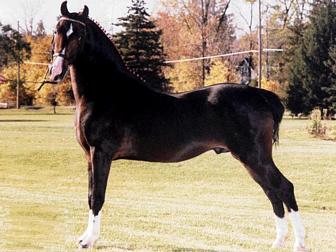
OVERVIEW
The Hackney Horse was first bred in the county of Norfolk, England. Norfolk enjoyed a great reputation for breeding superlative trotters called Norfolk Trotters or Roadsters. It is from this type of horse that the Hackney is descended. In 1883, a group formed the Hackney Stud Book Society and hence the breed was officially created. The remarkable high-stepping gait of the Hackney made it a very attractive choice for show work in harness to elegant carriages. The breed, as well as its smaller form known as the Hackney Pony, remains extremely popular today as a show horse.
PHYSICAL DESCRIPTION
The Hackney horse has a fine small head with features expressive of its spirited nature. The nose is flat and the head is set high on the neck, which may be crested and is rather muscular. The barrel has good depth which rises to the croup. The shoulder is flat and muscular, the legs are clean with flat bone. The Hackney horse should stand between 14 and 15.3 hands. It appears most frequently in bay, brown, black and chestnut, usually with white markings on the legs. Perhaps the most distinguishing feature is its gait which is energetic and lofty at the walk and trot.
ORIGIN
The Hackney Horse is descended from the Norfolk Trotter, native to East Anglia, England. The most important influence in its history was by Shales (foaled in 1755), a son of Flying Childers and therefore a descendent of the Darley Arabian.
INTERESTING FACTS
Many breeds have been strongly influenced by the Thoroughbred, the Hackney Horse is one of these. The most superb examples of Norfolk Trotter were traced to Shales, a son of the great race horse, Flying Childers. Therefore, the Hackney is descended from the Darley Arabian, foremost among the foundation stallions of the Thoroughbred. A Norfolk Trotter was imported to America in 1822. He proved a major influence in the founding of the Standardbred breed.
INFLUENCES
1. Norfolk Trotter
2. Thoroughbred
3. Arabian
For more information:
American Hackney Horse Society
Listed as "Rare" by The American Livestock Breeds Conservancy (2004)